Most Common Pests In Cannabis: Spider Mites
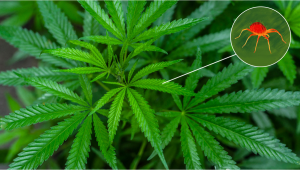
- 1. What are spider mites?
- 2. What do spider mites look like?
- 3. Where are they found?
- 4. What do spider mites do?
- 5. Spider mites symptoms
- 6. How to prevent them?
- 7. How to deal with them?
- 7. a. Environmental factors to keep in mind
- 7. b. Regular pruning
- 7. c. Hosing the crop regularly
- 7. d. Beneficial insects
- 7. e. Organic pesticides and essential oils
- 8. Other common pests that can cause issues for cannabis
- 9. In conclusion
Spider mites are the most common pest in cannabis seeds and plants. These bugs live in dirty indoor and outdoor grow spaces where they feed on chlorophyll and sap, webbing all over your precious plants.
1. What Are Spider Mites?
Spider mites are common in cannabis, these small mites hide inside the buds, sucking the liquid in your plants and leaving webs all over. It's fairly easy to eliminate them but make sure you spot them early because they can rot the buds, ruining your entire harvest really fast. These tiny mites are related to spiders, ticks, and other small Tetranychidae. They are a very common bug that attacks cannabis, seeking dark places in plants where they can lay eggs and continue to reproduce.
2. What Do Spider Mites Look Like?
These bugs are actually super tiny (around 0.5mm). They can be red or black and have 8 legs.
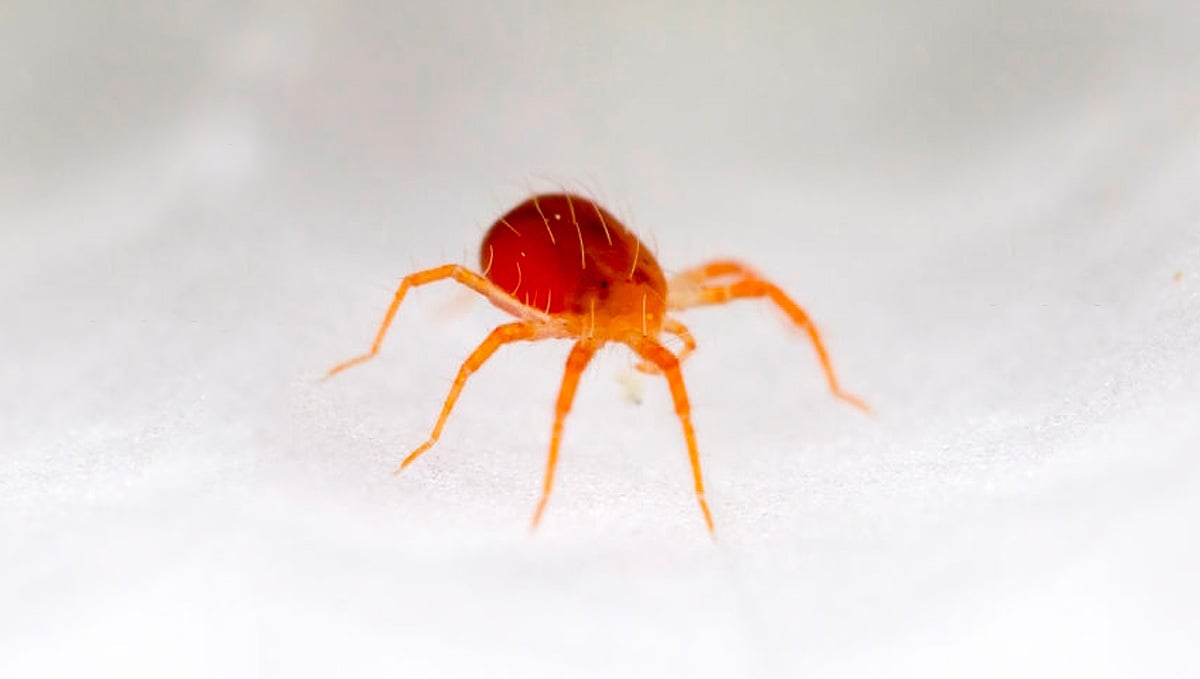
Because they’re so tiny, you’ll only be able to see tiny dots walking around your plant unless you have a 10x microscope available.
3. Where Are They Found?
Spider mites can be found walking all over the plant but you’ll usually find them on the underside of the fan leaves. That’s where they lay their eggs, protecting them from the sun and other elements that may affect them.
4. What Do Spider Mites Do?
These mites feed not only on sap but also on chlorophyll, damaging the plant. Even though this can have a toll on your plant, this is not the worst they can do. Spider mites can reproduce super fast and will use their web to protect their eggs. This means they will completely cover your plant in spider web if you don’t deal with them early. They can even lay eggs inside the buds and when the eggs hatch, they will start eating the inside of your bud, causing bud rot.
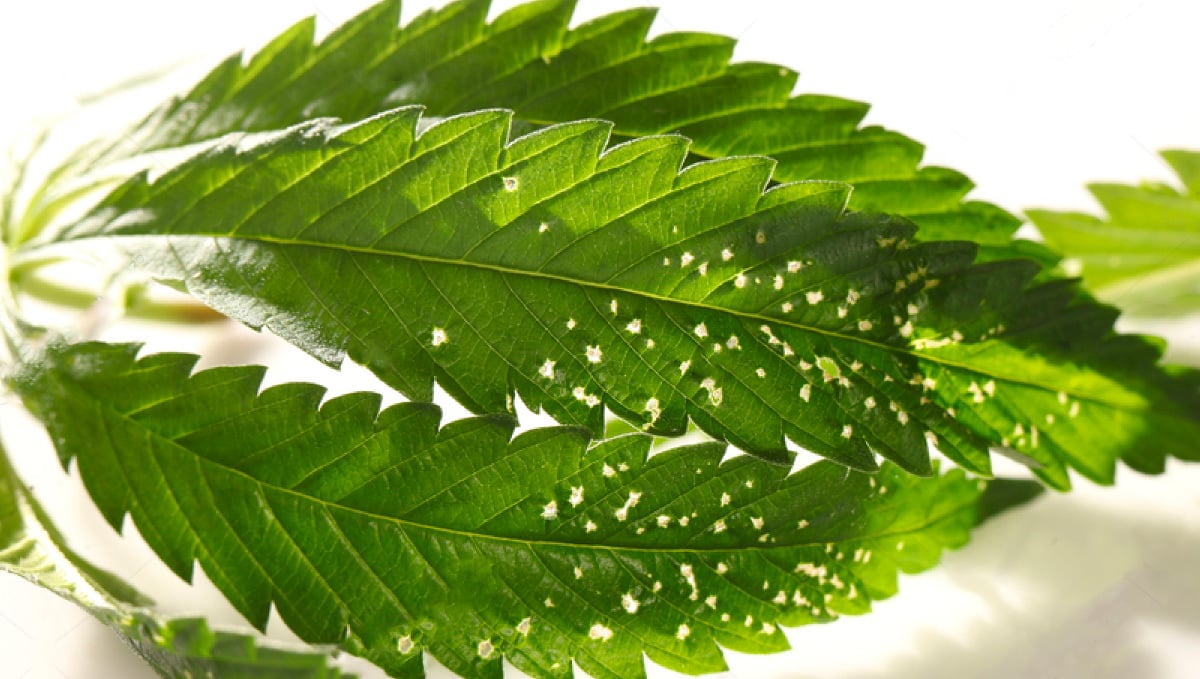
Even though the webbing won’t kill your plant, it will be impossible to remove it if you’re in the flowering stage as it can get stuck in the flowers. So although it doesn’t kill your plant, you will have to throw it away if you get seriously infested when flowering.
5. Spider Mites Symptoms
The symptoms you’ll see with spider mites are just signs of their presence. The first thing you see is tiny yellow or white spots, these are mites' bite marks and they are a sign that they are feeding on your plant. After that, you will start to see small transparent eggs stuck under the stems and leaves, this is a sign that the infestation is starting to grow.
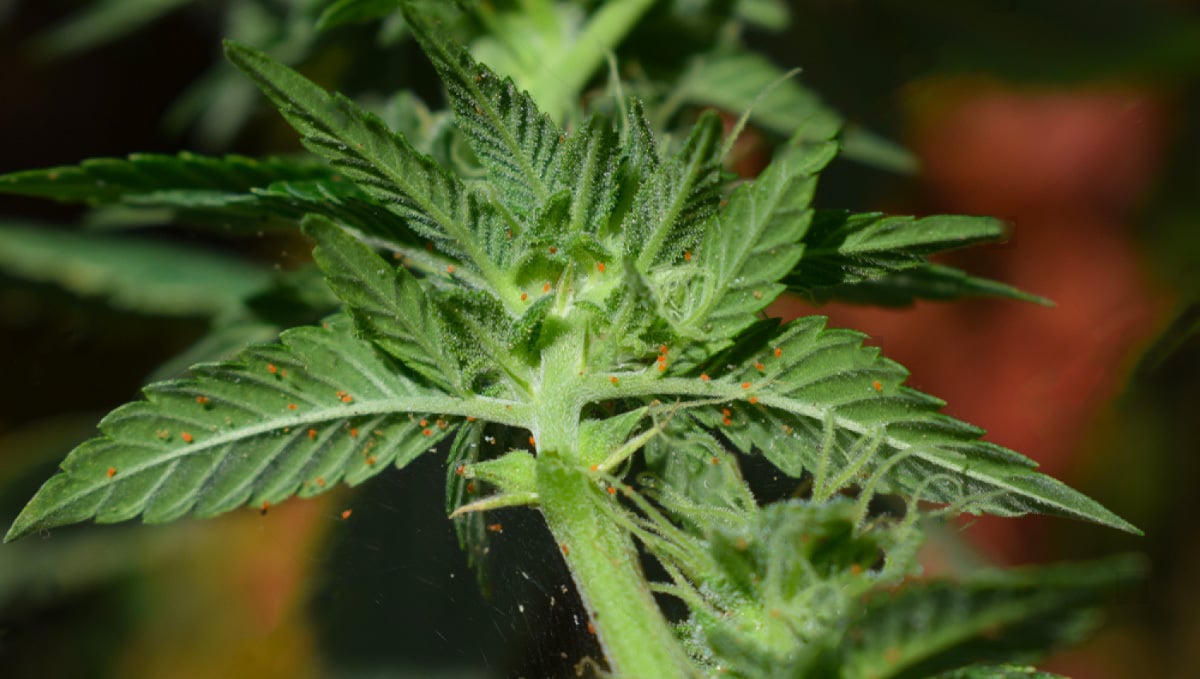
If left untreated for around a week, you’ll see what they can do. You will start to see webbing all around your plant and you’ll be able to see the mites walking all over your plant.
6. How To Prevent Them?
Although like with other pests like Mealy bugs, there is nothing you can do to avoid them 100% other than keeping a good growing environment. Keeping your growing space clean and quarantine clones (or other plants) before bringing them in with your plants is a good way to prevent them. Because spider mites don’t like wind, keeping a well-ventilated growing room can be an effective way to prevent them also. If you want to do everything you can to prevent them, you could slightly spray insecticides to prevent their appearance but this can affect your plant. But the best way really is to keep your space clean, with the appropriate temperature, humidity and ventilation.
7. How To Deal With Them?
If spotted in the early stages, it can be fairly easy to remove the eggs manually or with a high-pressure sprayer to knock them down. After you remove the excess, you can apply Neem oil or a mix of alcohol and water to eliminate the rest. Now if your plant is being taken over, it can be difficult, because they can cause bud rot and can hide inside the buds.
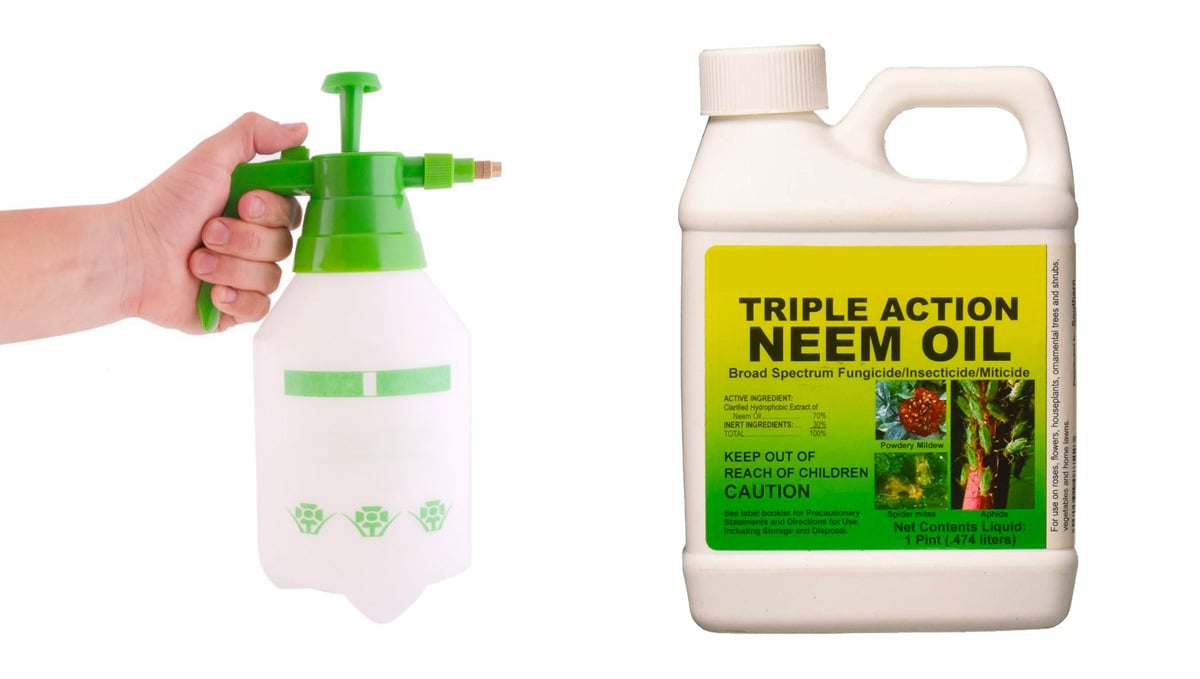
You will have to make the hard decision of completely eliminating them by applying harsher chemical products, with the risk of damaging your plant or applying organic and safer-to-use insecticides daily, with the risk of losing your plant to spider mites. If your plant is severely affected, the best thing to do is throw the plant out to avoid them spreading to your other plants. Spider mites are infamously good at quickly developing a natural resistance to many of the common pesticides used, and these pesticides can also have a harmful effect on other beneficial insects that gobble up spider mites. Not worry though, as there are some ways you can improve your chances of infestation prevention and control. By controlling the growing environment, regularly pruning your cannabis plants, and hosing your plants you will decrease the likelihood of spider mites (and other bugs) ever affecting your crop.
Environmental Factors to Keep in Mind
Spider mites are notorious for loving dry and hot conditions. They thrive in temps above 22ºC, which is also unfortunately in the perfect temp range for growing cannabis. Before you try to use any pesticide measure against spider mite, try bringing the grow room temp down to below 20ºC and keep it there for 2 to 3 days. Keep a close eye on your plants to make sure they are dealing with the lower temps.
Female spider mites can lay up to 100 eggs during their 70-odd day lifespan. These eggs can take anywhere between 3 to 19 days to hatch, depending on the room temperature. The lower the temperature, the slower the gestation period will be, and the more time you will have to deal with any unhatched eggs. It is a good idea to also create some extra airflow within the grow space, as spider mites hate windy conditions and will lay eggs less frequently if there is optimal airflow throughout the canopy.
Regular Pruning
Regularly pruning the older fan leaves from your weed plants can go a long way in preventing infestations from getting off the ground, and also stopping the spread of any small infestations. There are multiple pruning methods that growers implement to help with nutrient distribution, and all of these methods will help with removing areas for spider mites to lay their eggs. If you are already dealing with a small infestation, check your whole crop top to toe. Remove each and every site where you see any signs of infestation. Don't worry about removing too much plant material, as it is in the plant's best interests to banish the mites totally.
If your crop is showing signs of a large-scale infestation then you may have to consider sacrificing the infected plants to save the healthy ones. Spider mite infestations can spread quicker than wildfire, and once a big infestation has taken hold it can be extremely difficult to control it. What's better, a couple of healthy plants making it to harvest, or a full crop of infested plants that do not reach their potential and maybe so badly infested that you cannot enjoy the buds either way?
Hosing the Crop Regularly
Hosing your crop is another way to help prevent infestations and also slow the rate of spread if there are spider mites present. You can hose them down with regular tap water but in general, it's a good idea to grab a sprayer bottle from the closest garden store and use water that has been pH balanced.
Washing your plants like this will help remove any active spider mites, and also dislodge the unhatched eggs that will inevitably be hiding somewhere. Hosing can be done as often as you see fit, but if your crop is in the later stages of the flowering cycle be careful with the bud sites.
Many cannabis cultivators like to use a mixture of water and alcohol to spray the plants. Any rubbing alcohol will do, and you want to make the mixture with a ratio of 9 parts water 1 part alcohol. This mixture will kill the mites and eggs pretty quickly, while the plant itself will remain unaffected.
Beneficial Insects
There are a bunch of insects you can add to a grow room that love to eat spider mites, and other nasty bugs. They do not affect the plants themselves in any way, and while they are not suitable for big infestations, they can help control and prevent smaller-scale problems. The best bugs to introduce for spider mite control are:
- Ladybugs
- Lacewings
- Minute pirate bugs
- Predatory mites
- Six spotted thrips
- Western flower thrips
Organic Pesticides and Essential Oils
There is now a wide range of organic pesticides available on the market, with many of them doing a great job of controlling and preventing spider mite infestations. Products like Spinosad, Essentria IC3, SM-90, and NukeEm are all pretty budget-friendly and will do a great job with spider mite prevention. We have already briefly touched on neem oil, but let's have a bit more of an in-depth look at this fantastic product. Neem oil is, without a shadow of a doubt, the most popular organic spider mite prevention option currently available. Why is it so popular?
There are a few key reasons. It is very safe and extremely effective at controlling not just spider mites, but also most other bugs and fungus types that are known to attack cannabis crops while almost magically leaving those beneficial insects that we love totally unaffected. To make a Neem oil foliar spray simply mix together 500ml of water, a tablespoon of neem oil, and a couple of drops of insecticidal soap. The soap (or silica) helps emulsify the oil and water, while also boosting the insecticidal qualities of the spray. This can be used regularly, even before you start to suspect that there may be a spider mite issue with your crop. Give every plant a good spray, top to bottom, and remember to spray the underside of all the leaves.
Do not use this spray in the last 2 weeks or so of flower, and always protect any budding sites from the spray as neem oil and smokable cannabis are the best of friends. There is no health risk as such, but the oil mixture can have an adverse effect on the quality and yield of the harvest if applied to the bedding sites. If you have no access to neem oil, there is a range of other essential oils that can take its place. These include:
- Lemon oil
- Peppermint oil
- Rosemary oil
- Eucalyptus oil
- Cinnamon oil
- Lavender oil
- Tea Tree oil
While these oils may not be as effective as neem, they can be used in the same way and will have some insecticidal and fungicidal benefits.
8. Other Common Pests that Can Cause Issues for Cannabis
Right, we've delved deep into spider mites and the destruction that they can bring to a cannabis crop, indoors or out, but how about other creepy crawlies? How many other little annoyances are out there? A bunch, that's how many...
Aphids
These little green bugs, which resemble tiny pearls of jade, are often found on the leaves and buds of your cannabis plant. They can cause damage to the stems and leaves by sucking out their essential juices. To get rid of these, you should try spraying your plants with a mixture of soap and water, as this will disrupt their exoskeleton and get rid of them.
Fungus Gnats
These small flying insects resemble fruit flies and can be found around damp soil. They lay their eggs in the soil, which hatch into larvae that feed on roots, thus causing damage to the cannabis plant. The adult versions of Fungus Gnats are actually pretty harmless, but the larvae can cause real problems. To get rid of them, you’ll need to let your soil dry out more between waterings and use a natural insecticide, such as neem oil or thyme oil. Diatomaceous Earth can also be used as a preventative measure.
Whiteflies
These tiny white bugs that look like small moths love the warmer weather and higher humidity that indoor cannabis gardens can bring. They love to feed on the sap of your cannabis plant’s leaves and stems. To get rid of these, you should try spraying your plants with an insecticide made specifically for them, or using yellow or blue sticky traps. You can also use a natural insecticide, such as neem oil, thyme oil, or garlic spray.
Mealybugs
These soft-bodied bugs have a white and fuzzy appearance and, just like whiteflies, love to feed on the sap of your cannabis plant’s leaves and stems. To get rid of these, you should try spraying your plants with an insecticide made specifically for them or using a natural insecticide, such as neem oil or thyme oil. You can also use cotton swabs dipped in rubbing alcohol to manually remove any mealybugs you find on your plant’s stems and leaves.
Scale Insects
Scale Insects are the most common pest issue for growers in the northern pacific region of the USA, and boy can they be a real pain! These little hard-shelled bugs look like small bumps on the stems and leaves of your cannabis plants and can cause a lot of damage by sucking out essential juices. There are a bunch of natural and synthetic options that can be used in the battle against Scale Insects, but your best weapon is to try and keep your environment clean and free of debris, as these buggers love to hide in the small nooks and crannies!
Broad Mites
These little bugs are tricky to spot, as they’re often confused with spider mites. They’re tiny and look like little white specks, so you need to take a very close look at the underside of your plant's leaves to see if you have any. These nasty pests affect young growth the most, causing it to become distorted and stunted.
Diatomaceous Earth is a good preventative option, but if the infestation has taken hold then it's time for stronger countermeasures. A mixture of 2 liters of water, 2 teaspoons of insecticidal soap, and a good glug of neem oil is pretty effective. You can also use yellow sticky traps to help attract and capture any Broad Mites that may be lurking around your garden.
Caterpillars
Caterpillars are much more commonly found in outdoor cannabis gardens than inside a grow tent or room (although they can still find their way in at times). They love nothing more than chowing down on the fresh, younger growth - whether it be leaves, buds, branches, or stems - caterpillars can decimate a large crop in quick time, so be sure to be on the lookout for any telltale signs. Spinosad spray is your best line of defense against these little bast***s. Give the whole plants a good old dousing, allow them to dry out, then hit them again. You should also physically remove them every time you see one wriggling about.
9. In Conclusion
Spider mites are the worst bugs that can attack your plant. Even though they don’t feed on the roots or something more serious like Fungus gnats, they can lay eggs inside the buds, being able to compromise the entire main cola. Their webbing can also get stuck to the trichomes on the buds and it will be impossible to remove them completely, affecting yields and quality. As with all other pests, we recommend checking your plants every day and take action as soon as you see any sign of bugs.










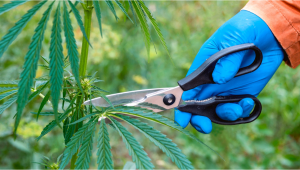
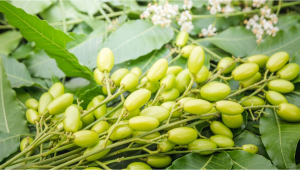



Comments